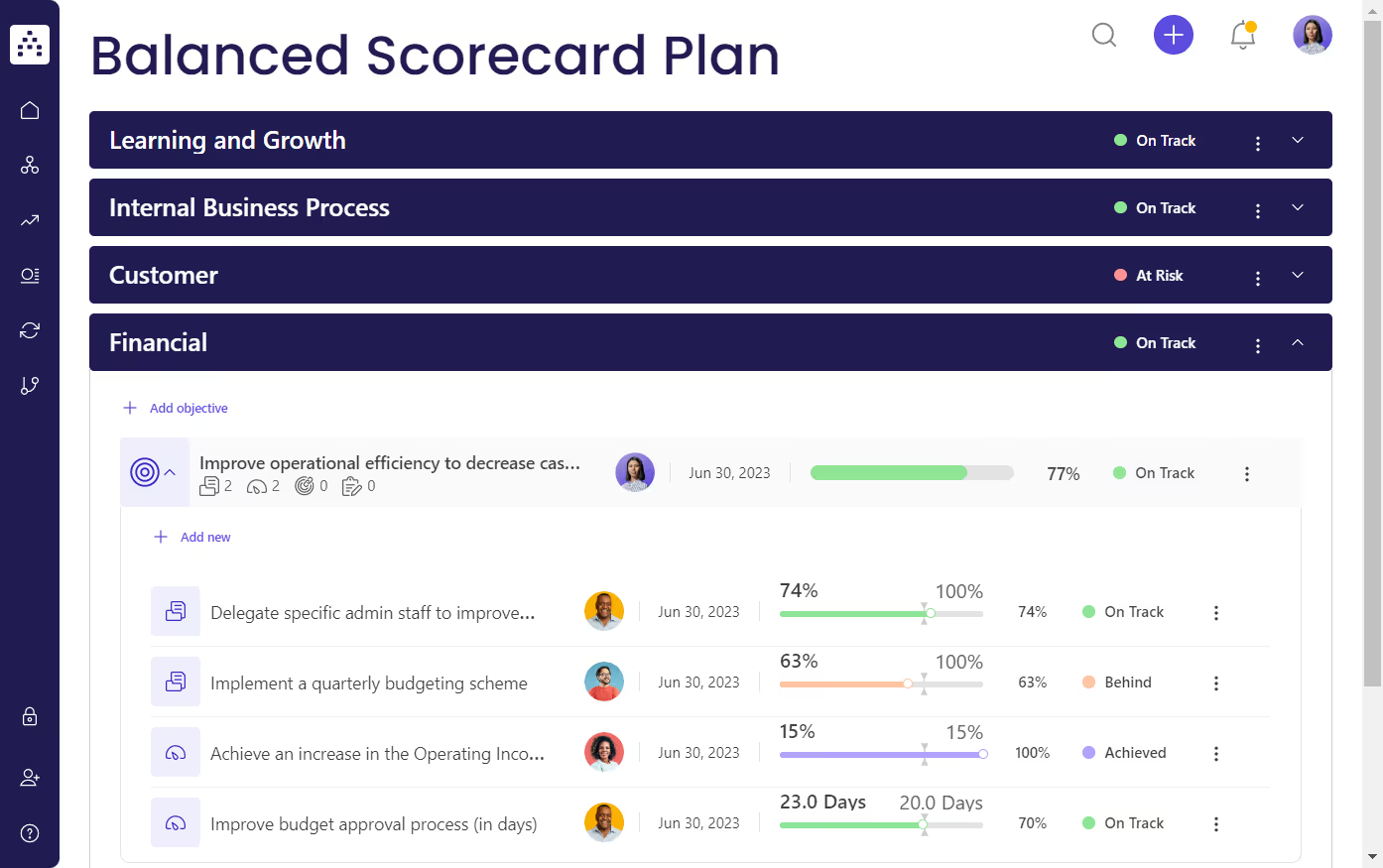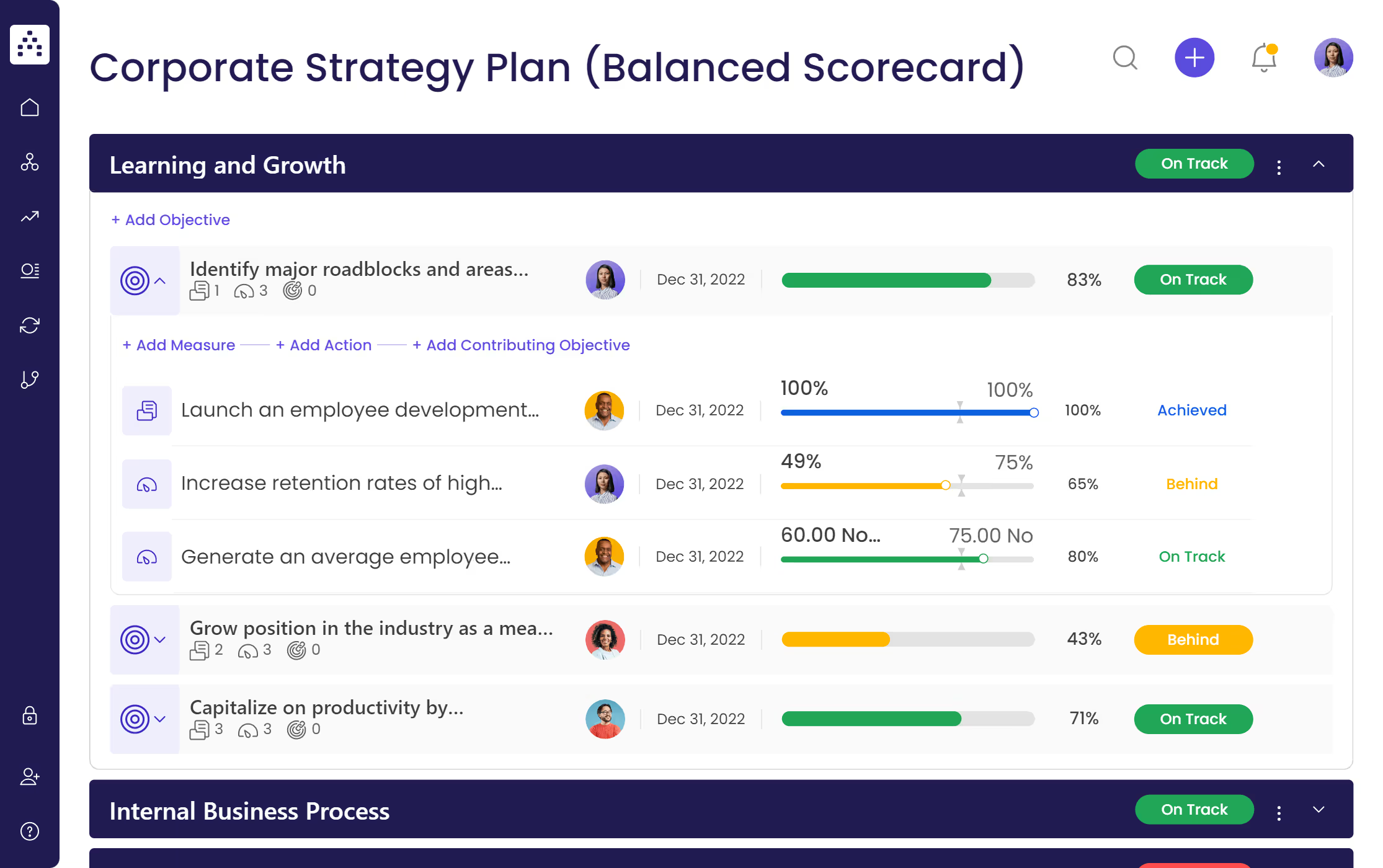What is a Balanced Scorecard Template?
The Balanced Scorecard is one of the best-known strategy frameworks ever created. The Balanced Scorecard essentially calls for organizations to create a set of internal metrics that will help them to assess their business performance in 4 key areas (referred to as 'perspectives'):
- Financial perspective: This perspective focuses on the financial performance of the organization, such as profitability, revenue growth, and return on investment.
- Customer perspective: This perspective looks at how the organization is performing from the customer's point of view, including customer satisfaction, retention, and loyalty.
- Internal process perspective: This perspective focuses on the organization's internal processes and operations, such as efficiency, quality, and productivity.
- Learning and growth perspective: This perspective looks at the organization's ability to learn and grow, including employee development, innovation, and organizational culture.
The Balanced Scorecard framework helps organizations to align their strategic objectives with their day-to-day activities, and to track and monitor their progress towards those objectives. It can be used as part of an organization's strategic planning process to identify areas for improvement and to make data-driven decisions. Many companies and organizations use a Balanced Scorecard template to help them implement the framework.
A Balanced Scorecard template is a tool that helps companies and organizations implement the balanced scorecard framework with ease. Our Cascade's Balanced Scorecard template provides a structured plan for detecting objectives, actions, projects, and key performance indicators (KPIs) that fall into each of the balanced scorecard perspectives, ensuring that everyone on the team is aligned and focused. The template also allows for tracking progress towards desired outcomes, connecting the Balanced Scorecard plan to real and impactful execution. It is industry agnostic and can be used by different teams and functions, and is customizable to fit the specific needs of an organization. Overall, a Balanced Scorecard template is a valuable resource for any organization looking to effectively implement and use the balanced scorecard framework.
What's included in this Balanced Scorecard template?
- 4x Balanced Scorecard Focus Areas
The Balanced Scorecard template's focus areas correspond to the four main components of this framework, known as the four perspectives. These are the Financial, Customer, Internal Business Process, and Learning and Growth perspectives. Each perspective focuses on different aspects of the business and provides a way to measure the organization's performance. - 12x Balanced Scorecard Objectives
The objectives are the specific goals that the organization wants to achieve in each perspective. The template includes 12 objectives, such as: creating a tangible roadmap from the current financial state to a more successful profitable future state; improving customer satisfaction and generating a consumer-centric approach; aiming to excel across the board and identifying major roadblocks and areas where the organization lacks critical competencies to proceed to the next stage. - 29x Balanced Scorecard Projects
Projects are the specific actions that the organization will take to achieve its objectives. The template includes 29 projects, such as: improving inventory system; incentivizing early payments; streamlining operations to reduce costs; and launching an employee development scheme. - 31x Balanced Scorecard KPIs
The measures are the key performance indicators (KPIs) that the organization will use to track its progress and determine whether it is achieving its objectives. The template includes 31 KPIs, such as: increasing average sales; reducing customer churn; achieving an increase in the operating income margin, and growing social media followers.
Let's take a closer look! 👀
As we can see in the image below, the Balanced Scorecard template includes four main focus areas: Financial, Customer, Internal Business Process, and Learning and Growth. If we take a closer look at the Financial focus area, we can see an example of one of the objectives related to it, which is 'Improve operational efficiency to decrease cash burn'.
This objective is associated with two projects, 'Delegate specific admin staff to improve bookkeeping and accounting operations' and 'Implement a quarterly budgeting scheme', and two KPIs, 'Achieve an increase in the Operating Income Margin' and 'Improve budget approval process (in days)'.
With this template, you will be able to monitor and have real-time information on the progress of the projects and KPIs, including their deadlines. As we can see in the example, the objective is 'on track' but one of the projects is 'behind'.

Who is this Balanced Scorecard strategy template for?
The Balanced Scorecard template is designed to be used by a wide range of organizations, both small and large. It is an effective tool for any company that wants to ensure that its efforts are aligned with its overall strategy and mission. This template is ideal for organizations of any industry (like manufacturing, retail, transportation, healthcare, hospitality) that are looking for a comprehensive approach to performance management, as it allows them to track and measure progress across multiple areas of their business, including financial, customer, internal processes, and learning and growth. Whether you are a small startup or a large multinational corporation, this Balanced Scorecard strategy template can help you to achieve your organizational objectives and drive sustainable growth.
Why should I use a Balanced Scorecard template?
There are several reasons why an organization should use a Balanced Scorecard template. Firstly, it provides a structured approach to performance management by allowing the organization to track and measure progress across the four perspectives (financial, customer, internal processes, and learning and growth). This allows the organization to identify and address areas of weakness and focus on the areas that are most critical to achieving its goals.
It also helps align the organization's efforts with its overall strategy and mission by ensuring that everyone on the team is focused on the same objectives and KPIs. This promotes a culture of accountability and ensures that everyone is working towards the same goal.
The template is customizable and industry agnostic, which means it can be adapted to fit the specific needs of an organization regardless of its size or industry. This makes it a versatile tool that can be used by different teams and functions within the organization.
Additionally, the template allows to track the progression towards the desired outcomes, connecting the Balanced Scorecard plan to real and impactful execution. This allows the organization to see the progress and make adjustments if needed, to achieve the desired outcome.
How do I use this Balanced Scorecard strategy template?
You can use this template to analyze your current strategic goals to make sure your company’s performance is actionable and successful in executing your objectives.
1. Define clear examples of your focus areas
What do you want to achieve by creating a Balanced Scorecard strategy template? Are there particular departments or areas within your organization that you want to focus on? Thinking of answers to these questions can assist you in devising potential focus areas.
Examples of focus areas for this balanced scorecard are Financial, Customer, Internal Business Process, and Learning and Growth.
2. Think about the objectives that could fall under that focus area
What targets can you set to clarify the expectations of others and yourself in your organization? You can set various objectives that can fall under the focus areas you came up with earlier. It’s important to consider whether you want these objectives to be tied to a specific individual and their purpose in the organization. Individuals that are in charge of these objectives can also be in charge of delegating and managing all the respective KPIs and projects that fall under this given objective.
Objectives under the focus area are Financial ould include Create a tangible road-map; Improve operational efficiency to decrease cash burn; Improve company cash flow.
3. Set yourself measurable targets (KPIs) to tackle the objective
How do you want to quantify the value of your given objectives? To what extent are these targets deviating or contributing to the completion and/or success of your desired objectives? Coming up with a few KPIs is extremely important when considering this, as KPIs can provide you with measurable indicators about the success, status, and progress of your goals.
4. Implement related projects to achieve the Product Management KPIs
Besides using KPIs to measure your goals, you can also set up various tasks or projects under each objective, which can facilitate in achieving these said objectives.
Examples of projects for the Financial focus area could include: Improve Inventory System; Streamline operations, Work with employees to unbundle features, Reassess current strategy plan, Improve booking keeping and accounting process; Implement a quarterly budgeting scheme.
5. Utilize Cascade tools to track and visualize performance
Up until now, we’ve only focused on the measurable, numerical side of things; using Cascade tools such as widgets can visually depict the numerical progress of your KPIs and goals. These visualizations will help you to easily track and see your progress on a specific KPI and project.
For instance, if a project is ...and you’re only 60% complete it’ll be easily and clearly displayed and you can see how much longer you have left to complete it. You can also accordingly customize the display, for instance, you can include an Owner section to show who’s responsible for completing that KPI or Project, or time period to display how long you have left and the progress you’ve made up till now.
FAQs about Balanced Scorecard templates 🧐
How do I create a Balanced Scorecard template?
Creating a Balanced Scorecard template can be a daunting task, but with Cascade's ready-to-use Balanced Scorecard template, you don't have to build it from scratch. Our template is free to use and customizable to fit the specific needs of your organization. It can be used by companies of any size and industry, making it a versatile tool for any organization looking to implement the balanced scorecard framework. Just access our Balanced Scorecard template and customize it to your organization's needs.
If you prefer to build the balanced scorecard template yourself, it is recommended to follow these steps:
- Identify the organizational objectives and mission
- Divide the objectives into four perspectives: financial, customer, internal process, and learning and growth
- Identify the key performance indicators (KPIs) that align with each perspective
- Develop action plans and projects to achieve the objectives and KPIs
- Continuously track and measure progress, and make adjustments as needed to ensure alignment with the organization's overall strategy and mission.
Keep in mind that creating a balanced scorecard template from scratch can be time-consuming and requires a thorough understanding of the balanced scorecard framework and the specific needs of your organization. However, with a clear plan and a dedicated team, it can be done successfully.
What are the four main components of a balanced scorecard?
The Balanced Scorecard framework is composed of four main components, known as the four perspectives:
Financial perspective: This perspective focuses on financial performance and includes key performance indicators (KPIs) such as revenue, profit, and return on investment (ROI). The goal is to measure the financial impact of the organization's strategy and actions.
Customer perspective: This perspective focuses on the organization's customers and includes KPIs such as customer satisfaction, retention, and loyalty. The goal is to measure the value the organization is providing to its customers.
Internal process perspective: This perspective focuses on the internal processes and operations of the organization and includes KPIs such as efficiency, productivity, and quality. The goal is to measure the effectiveness of the organization's internal processes and operations.
Learning and growth perspective: This perspective focuses on the organization's ability to learn, adapt, and innovate. It includes KPIs such as employee engagement, training and development, and technology usage. The goal is to measure the organization's ability to improve and sustain its performance over time.


